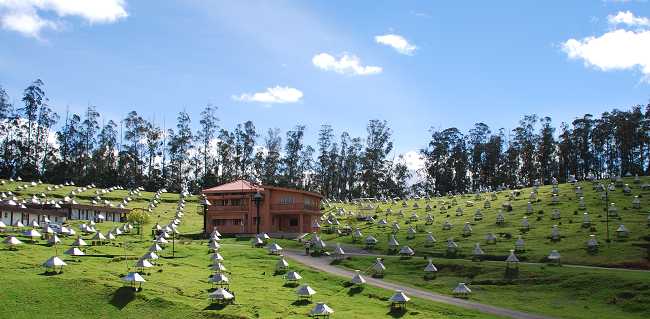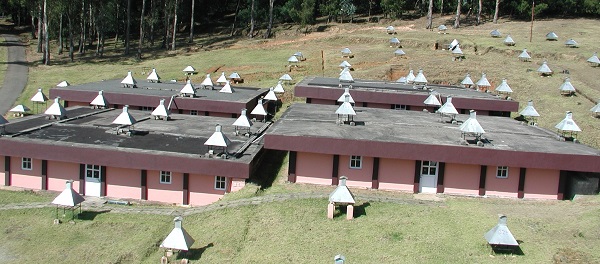

Thunderstorms are frightening and a spectacular demonstration of one of the most violent phenomenon in our atmosphere. Nearly three centuries back in 1749, Benjamin Franklin through his famous kite-experiment during a thunderstorm showed that the discharge of electric charges stored in clouds was responsible for the astonishing phenomena of thunder and lightning.
Thunderstorms are very common in our country especially during the Monsoon season and occur frequently in other parts of the world. Spectacular and awe inspiring they may be, but there is a dark side of thunderstorms, as a leading cause of loss of human lives from a natural disaster. In India, alone they cost hundreds of lives every year. Gaining insights into the properties of thunderstorms could be the first step towards predicting their behavior and possibly mitigating their deadly impact on the society.

Physical properties that characterize a thunderstorm include, its total area, the high voltage present, the energy stored, total electric charge, and the power generated etc. Unfortunately up until now, most of these properties were not well measured. But all that changed with the recent discovery by the GRAPES-3 (Gamma Ray Astronomy PeV EnergieS phase-3) Muon telescope operated by the Tata Institute of Fundamental Research in India. The telescope nestled within the rolling hills of Nilgiri Muontains near the town of Ooty is a unique scientific facility created for the study of high energy particles called cosmic rays which reach us from far corners of the universe.
The cosmic rays discovered more than a century back in 1912 mostly comprise of protons and other heavier nuclei moving near the speed of light. The cosmic rays interact with nitrogen and oxygen in the air to produce several secondary particles. This is due to Einstein’s equation E=mC2 which allows the conversion of energy of cosmic rays into creation of new particles, some of them decay into high energy Muons. The Muons travel down to Earth near the speed of light and get detected by the GRAPES-3 Muon telescope.

What makes our Muon telescope unique in the world is its capability to accurately measure the Muon intensity along 169 independent directions in the sky rather like a 169 pixel camera that is continuously recording the Muon image of the atmosphere above.
Because of an extremely complex structure and a short life of several minutes, the understanding of the inner working of thunderstorms was slow in coming. The first landmark advance after the work of Franklin was by C.T.R. Wilson (1927 Nobel in Physics) who identified the dipole structure of thunderstorms and predicted 90 years ago that an incredibly large electric voltage of 1,000,000,00 Volt (1 GV) could develop across a powerful thunderstorm! Hariharan and 21 other scientists drawn from six different institutes and universities in India and Japan are members of the GRAPES-3 experiment. By Muon imaging they measured an electric potential (voltage) of 1,300,000,000 Volts (1.3 GV) across a thunderstorm that occurred on 1 December 2014 in result published in Physical Review Letters (https://journals.aps.org/prl/abstract/10.1103/PhysRevLett.122.105101 [3]). This measurements has thus, verified the nearly century old prediction of Wilson. Remarkably, this voltage is 10 times larger than previous record maximum voltage of 0.13 GV measured by scientists in the USA.

High energy photons are called gamma rays which possess a million times more energy (MeV) than the ordinary light. Scientific surprises unleashed by this discovery extend beyond just a record-breaking voltage inside a thunderstorm. A quarter of a century ago, a NASA satellite discovered short-lived flashes of gamma rays emerging from the atmosphere and were named Terrestrial Gamma ray Flashes or TGFs for short. Shortly thereafter, the source of the TGFs were found to be large thunderstorms occurring in the lower atmosphere. The energy of these gamma rays was found to be quite large (20 MeV) and soon newer satellites showed the presence of gamma rays of 100 MeV in TGFs. The only known mechanism for the production of such high energy gamma rays is from the interaction of electrons or positrons of still higher energies. It turns out that the existence of GV potentials is absolutely essential for the acceleration of electrons to GeV energies and that could in turn produce 100 MeV gamma rays seen in TGFs and provide a solution to this 25 year old riddle.
The high sensitivity of the GRAPES-3 Muon telescope, when combined with the additional information from a set of four electric field monitors, allowed several of the properties of this thunderstorm to be measured for the first time. This thunderstorm can be considered a giant (400 km2) capacitor, storing an energy of about trillion Joules. It was moving at a speed of 60 km/hour at an altitude of 11.4 km above sea level, exactly where passenger jets fly. The presence of such huge voltages in supercharged thunderclouds makes them a serious threat to the passenger safety.
The 2 GW power supplied by the strong thermal currents sustaining this thunderstorm were comparable to the existing single biggest nuclear reactor, hydroelectric and thermal power generators. If only the energy of this thunderstorm could have been harnessed, it would have powered a large metropolis like New Delhi or Mumbai for its entire duration of 18 minutes.
(The paper is the author’s individual scholastic articulation. The author certifies that the article/paper is original in content, unpublished and it has not been submitted for publication/web upload elsewhere, and that the facts and figures quoted are duly referenced, as needed, and are believed to be correct). (The paper does not necessarily represent the organisational stance... More >>
Links:
[1] https://www.vifindia.org/2019/march/18/breakthrough-towards-resolving-century-old-riddle-of-deadly-thunderstorm
[2] https://www.vifindia.org/author/Prof-Sunil-Gupta
[3] https://journals.aps.org/prl/abstract/10.1103/PhysRevLett.122.105101
[4] https://encrypted-tbn0.gstatic.com/images?q=tbn:ANd9GcTdCZqu-PYX86AObdXKpJb1mtbIXHfLO6tI_V7siUj21tMTYw5X
[5] http://www.facebook.com/sharer.php?title=Breakthrough towards Resolving Century Old Riddle of Deadly Thunderstorms by a Muon Telescope in India&desc=&images=https://www.vifindia.org/sites/default/files/Thunderstorm1.jpg&u=https://www.vifindia.org/2019/march/18/breakthrough-towards-resolving-century-old-riddle-of-deadly-thunderstorm
[6] http://twitter.com/share?text=Breakthrough towards Resolving Century Old Riddle of Deadly Thunderstorms by a Muon Telescope in India&url=https://www.vifindia.org/2019/march/18/breakthrough-towards-resolving-century-old-riddle-of-deadly-thunderstorm&via=Azure Power
[7] whatsapp://send?text=https://www.vifindia.org/2019/march/18/breakthrough-towards-resolving-century-old-riddle-of-deadly-thunderstorm
[8] https://telegram.me/share/url?text=Breakthrough towards Resolving Century Old Riddle of Deadly Thunderstorms by a Muon Telescope in India&url=https://www.vifindia.org/2019/march/18/breakthrough-towards-resolving-century-old-riddle-of-deadly-thunderstorm